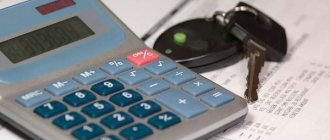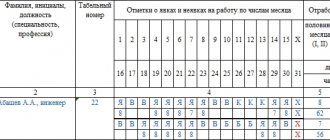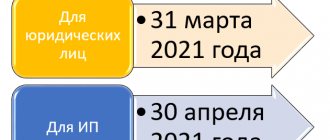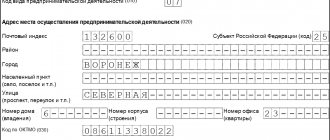Is it possible to work with VAT using simplified language?
As a general rule, companies and individual entrepreneurs using a simplified taxation system are exempt from paying VAT.
But sometimes, in the interests of business, it is necessary to pay a tax to attract customers. The law does not prohibit doing this - every “simplified” person has the right to issue an invoice and transfer VAT to the budget. In addition, there are operations in which working with VAT is the responsibility of an organization or entrepreneur using the simplified tax system. When performing such transactions, “simplified” not only can, but must issue invoices and pay value added tax.
Fill out, check and submit your VAT return online for free
When do you have to pay VAT under the simplified taxation system?
Let's name the most common cases when you have to transfer VAT under the simplified system.
1. When issuing invoices with allocated VAT . Often clients using the general taxation system refuse to make transactions with suppliers using the simplified tax system. The fact is that “simplified” companies are not VAT payers and are not required to issue invoices. As a result, buyers are unable to deduct input tax.
To get out of this situation, sellers voluntarily issue invoices with an allocated VAT amount. This allows customers to apply the deduction. The supplier using the simplified tax system, in turn, must transfer to the budget the VAT indicated in the invoice (subclause 1, clause 5, article 173 of the Tax Code of the Russian Federation).
ATTENTION . Many sellers approach the issue differently. They register two legal entities: one is transferred to the simplified system, and the second is left on the general one. If the client uses a special regime and does not need an invoice, then the contract with him is signed by the first organization. If the buyer is on OSNO, then the second company becomes its supplier.
2. When importing goods. One of the operations in which the simplifier must pay VAT is the import of goods. This is directly stated in paragraph 2 of Article 346.11 of the Tax Code of the Russian Federation.
If the supplier is located in a member country of the Eurasian Economic Union (EAEU), then the tax must be transferred after the importer accepts the goods for accounting. The taxable base will be the sum of two values: the cost of the goods and the excise tax (for excisable products).
If the foreign supplier is not located in the EAEU, then value added tax must be paid at customs. In this case, the taxable base is the sum of the cost of the goods, customs duties and excise taxes (for excisable products).
The VAT rate in general is 20%, and for certain goods - 10%. There is also a list of goods that are exempt from VAT upon import. These are cultural values, books for libraries, etc. (Article 150 of the Tax Code of the Russian Federation).
Fill out and submit a new VAT declaration online for free when importing from EAEU countries
3. In case of trust management of property. Another operation that obliges a company to remit VAT to the simplified tax system is the sale of property received by it in trust. According to Article 174.1 of the Tax Code of the Russian Federation, the trustee must issue an invoice. In this case, in the line “Seller” you should make a note “D.U.” - this is the requirement of paragraph 3 of Article 1012 of the Civil Code of the Russian Federation.
IMPORTANT. The remuneration for services that the trustee under the simplified tax system receives from the founder of the management (that is, from the owner of the property) is not subject to VAT.
Obligation to pay VAT
Despite the fact that “simplified” people are not VAT payers, in a number of cases they have an obligation to pay tax to the budget. Let's look at some of them in more detail.
Goods are imported
Import of goods into the territory of the Russian Federation and other territories under its jurisdiction, in accordance with Art. 146 of the Tax Code of the Russian Federation is subject to taxation. In this case, companies using the simplified tax system must pay VAT (clauses 2, 3 of Article 346.11 of the Tax Code of the Russian Federation). There is a peculiarity here regarding the timing of VAT payment. Thus, according to the general rules, the deadlines for paying VAT when importing goods depend on the customs procedure under which the goods are placed (Article 82 of the Customs Code of the Customs Union):
- When releasing goods for domestic consumption, the tax is paid before their release (Clause 3, Article 211 of the Labor Code of the Customs Union).
- If goods are placed under the customs procedure of temporary import (admission), VAT is paid before the release of goods in accordance with the specified customs procedure upon payment of the entire amount of import customs duties and taxes payable for the established period of temporary import (clause 3 of Article 283 of the Customs Code of the Customs Union) and etc.
In addition, customs legislation provides in a number of cases special deadlines for paying VAT.
In general, the amount of VAT that must be paid to the budget when importing goods into the customs territory of the Russian Federation is determined by the formulas:
VAT = Tax base × Rate
Tax base = Customs value + Customs duty + Excise tax
The VAT rate is applied depending on the type of goods: 10 or 18%. VAT payable to the budget is calculated in Russian rubles and rounded to the second decimal place.
When importing goods from member states of the Eurasian Economic Union, the amount of VAT payable is determined by the formula:
VAT = (Transaction price + Excise tax) × 18% (or 10%)
In this situation, the tax is paid no later than the 20th day of the month following the month in which the goods were accepted for accounting.
An invoice is issued with allocated VAT
When “simplers” issue an invoice, including for an advance payment, with VAT allocated in it, they must transfer the VAT to the budget (clause 5 of Article 173 of the Tax Code of the Russian Federation). Also in this case, the company has an additional obligation under the simplified tax system - to submit a VAT return. You must report this tax electronically using the TKS no later than the 25th day of the month following the expired tax period.
In addition, if “simplified” intermediaries issue and (or) receive invoices when carrying out activities in the interests of another person, they are required to keep logs of received and issued invoices (clause 3.1 of Article 169 of the Tax Code of the Russian Federation).
Commission agents and agents acting on their own behalf, as well as persons carrying out activities on the basis of transport expedition contracts in the interests of other persons and taking into account remunerations for the execution of these contracts as part of income under the simplified tax system, must keep a log of received and issued invoices.
Moreover, if “simplers” sell or purchase goods, works or services on their own behalf, they do not have to pay VAT. In this situation, an obligation arises to issue (reissue) invoices, highlighting the amount of VAT in them (clause 1 of Article 169 of the Tax Code of the Russian Federation).
Operations are carried out under partnership agreements
Companies using the simplified tax system must pay VAT to the budget if operations are carried out under a simple partnership agreement (joint activity agreement), investment partnership agreement, property trust management agreements or concession agreements on the territory of the Russian Federation (Article 174.1, Article 346.11 of the Tax Code of the Russian Federation). In addition, in this situation, “simplers” must submit a VAT return to the tax authority no later than the 25th day of the month following the expired tax period (clause 5 of Article 174, clause 4 of Article 174.1 of the Tax Code of the Russian Federation).
VAT refund under simplified tax system
An invoice with an allocated VAT amount, voluntarily issued by a simplifier, does not give him the right to deduct input tax. In the same way, it is impossible to deduct the value added tax paid by the importer using the simplified tax system.
The reason is that deductions are provided when purchasing goods (works, services) by VAT taxpayers (Article 172 of the Tax Code of the Russian Federation). But “simplifiers” are not one of them. This means that they are not entitled to deduction of input VAT.
If an organization or entrepreneur applies the simplified tax system with the object of taxation “income minus expenses,” then it will not be possible to attribute VAT to expenses. Yes, there is subclause 22 of clause 1 of Article 346.16 of the Tax Code of the Russian Federation, which allows you to include the amount of taxes and fees in expenses. But we are talking about taxes paid in accordance with the law. While the “simplifier” generates invoices and transfers VAT of his own free will. This means that this rule cannot be applied. This was indicated by the Russian Ministry of Finance in a letter dated November 9, 2016 No. 03-11-11/65552.
The situation is different with input VAT in trust management of property. The “simplified” manager has the right to deduct input VAT if he has an invoice from the supplier (clause 3 of Article 174.1 of the Tax Code of the Russian Federation).
Connect to the service for automatic reconciliation of invoices with counterparties
Accounting for input tax when transferring activities to the simplified tax system
When switching to the simplified tax system from the main mode, it is necessary to restore the input tax shown in accounting as reimbursed. This is due to the fact that, being on OSNO, the company subtracts input VAT from the total amount of tax payable, and in the simplified system this opportunity is lost.
It is not necessary to restore all VAT deductible, but only its share related to:
- Products purchased on OSNO, but not sold at the time of transition;
- Materials purchased at OSNO but not used;
- Intangible assets and fixed assets - in terms of their value in the residual value on the day of transition.
The restoration procedure boils down to the calculation of tax payable in an amount equal to the restored amount. Having switched to the “simplified” system, the company needs to pay the restored added tax, corresponding to the balances of inventory items in warehouses (purchased and paid for OSNO), as well as the cost of fixed assets and NAMA of the residual type. If a revaluation was performed for a non-current asset, its results are not taken into account when restoring.
The restoration process is carried out in the tax period preceding the transfer of the business to a simplified tax system. The restored value is recorded in expenses (it is not taken into account in the cost of these inventory items, intangible assets, fixed assets).
The restored input tax must be entered into the Sales Book, entries are made on the basis of those invoices on the basis of which the tax was previously deducted. It is necessary to take the same invoices and register the fact of restoration.
If a non-current asset was acquired a long time ago, but its useful life did not end at the time of transfer, then it is possible that there is no longer an invoice for it due to the end of its shelf life. In this case, the registration entry in the Book is made on the basis of a certificate - a document drawn up by an accountant in free form.
VAT under the simplified tax system in 2021
In a situation where the seller, using a simplified system, has issued an invoice to the supplier with an allocated amount of VAT, he must transfer the tax to the budget within the following terms:
- for the first quarter of 2021 - no later than April 27, May 25 and June 25, 2021;
- for the second quarter of 2021 - no later than July 27, August 25 and September 25, 2021;
- for the third quarter of 2021 - no later than October 26, November 25 and December 25, 2021;
- for the fourth quarter of 2021 - no later than January 25, February 25 and March 25, 2021.
To summarize, we note that although VAT under the simplified tax system in the general case does not need to be paid, the “simplified tax” can work with value added tax at will. To do this, it is enough to generate an invoice during implementation and highlight VAT in it. There are also operations when it is necessary to pay VAT under the simplified system. This includes, among other things, the import of goods and the sale of property to trustees.
Is it possible to avoid double taxation?
In some cases, when paying VAT to the budget, companies using the simplified tax system face double taxation when VAT amounts are included in sales revenue and at the same time are subject to a single “simplified” tax. For example, when the lease agreement for state property does not include VAT and the rent is transferred in the amount specified in the agreement, and the tenant pays VAT using the simplified tax system “at his own expense.” Or when the payer of the simplified tax system issues an invoice with allocated VAT, the amount of which he transfers to the budget (clause 5 of article 173 of the Tax Code of the Russian Federation).
However, from 2021, payers of the simplified tax system and unified agricultural tax who issue invoices will not have to take VAT into account in their income. Corresponding amendments to the Tax Code were made by Federal Law dated 04/06/15 No. 84-FZ. This law excludes from the revenue under the simplified tax system and unified agricultural tax the amounts of VAT received when issuing invoices with an allocated tax amount. The law also directly states that VAT amounts that are paid to the budget on invoices issued to customers are not included in expenses when calculating the Unified Agricultural Tax and the simplified tax system. Read more about this here.







